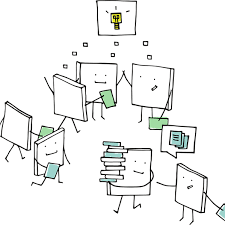Social learning theory is a process through which we learn from the people around us. It was first proposed by Albert Bandura in the 1960s and has been extensively studied since then. The theory has several elements that help to explain how we observe and learn from others. In this blog post, we will explore social learning theory in detail, and discuss its viability as a method of learning. We will also look at some examples of social learning in action!
Contents
Understanding Social Learning Theory

Social learning theory is a psychological concept that describes how people learn from each other. It focuses on the idea that people can learn by observing others, as well as through direct experience.
Importance of Social Learning Theory
Social learning theory is important because it helps us to understand how people learn. It also helps us to understand how people can change their behavior. And finally, it helps us to understand the importance of social interaction in learning.
History And Development
The theory was developed by renowned psychologist Albert Bandura, who studied how children learn to behave both inside and outside of the home. Bandura first proposed social learning theory in the 1960s. Since then, it has been extensively studied and developed. There are now several different elements to the theory, which help to explain how people learn from each other.
Postulates of Social Learning Theory
There are three key postulates of social learning theory:
- The first is that people can learn by observing others. This is called observational learning. Observational learning occurs when we see someone else doing something and then imitate their behavior. For example, if you see someone else riding a bike, you can quickly learn how to ride a bike yourself by observing their behavior.
- The second is that people can learn through direct experience. This is called experiential learning. Experiential learning happens when we try something ourselves and then learn from our own mistakes. For example, if you want to learn how to cook, you will need to try cooking a few different dishes yourself to get the hang of it.
- The third is that people can imitate the behaviors they see other people doing. This is called modeling. And modeling occurs when we see someone else doing something that we want to learn how to do. For example, if you want to learn how to bake a cake, you might model the behavior of someone who knows how to bake.
- And the fourth is that learning is a social process. This means that people learn best when they are interacting with other people. This means that learning can take place in a social setting such as a classroom or group discussion. For example, if you are learning about history in a class, you will learn more by discussing the topic with your classmates than by reading about it on your own.
NOTE: It’s important to note that any learning can be positive or negative. We can learn good behaviors from others, or we can learn bad behaviors.
Bandura’s 4 Elements of Social Learning Theory
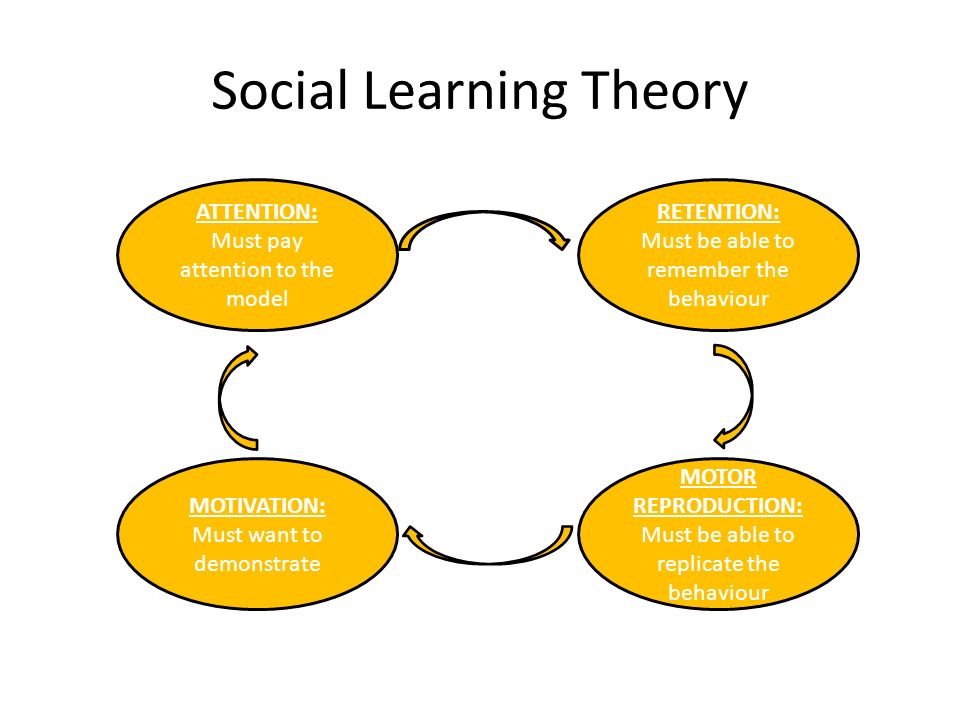
Bandura’s social learning theory contains four elements:
Attention: For learning to take place, we must pay attention to the person or thing that we want to learn from. For example, if you want to learn how to bake a cake, you will need to pay attention to someone who knows how to bake.
Retention: We must be able to remember what we have seen or experienced to learn from it. For example, if you see someone baking a cake, you will need to remember how they did it to bake a cake yourself.
Reproduction: We must be able to reproduce the behavior that we have seen or experienced to learn from it. For example, if you want to learn how to bake a cake, you will need to be able to reproduce the steps that you saw someone else take.
Motivation: We must be motivated to learn from what we have seen or experienced. For example, if you are not interested in baking, you are not likely to learn how to bake a cake simply by observing someone else.
Underpinning Concepts
In addition, there are underpinning concepts that support these four elements in action:
Reinforcement: Reinforcement occurs when we do something and it makes us feel good. For example, if you eat a piece of chocolate cake and then feel happy, the chocolate cake will have been reinforced. Reinforcement can be positive or negative, depending on whether it makes us feel good or bad.
Punishment: Punishment occurs when we do something and it makes us feel bad. For example, if you get in trouble at school for talking in class, the punishment will have been punished. Punishment can also be positive or negative, depending on whether it makes us feel good or bad.
Vicarious learning: Vicarious learning occurs when we see someone else doing something and then learn from their experience. For example, if you see your friend get in trouble for talking in class, you might vicariously learn from their experience and avoid talking in class yourself.
Factors Social Learning Theory Take Into Consideration
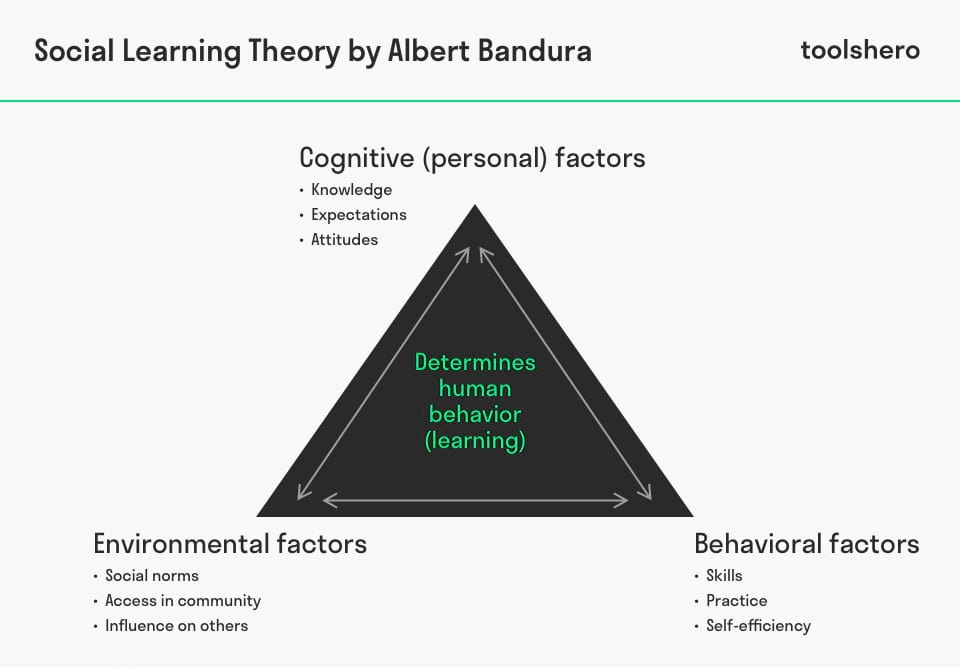
There are several factors that social learning theory takes into consideration:
Individual differences: Each person learns differently. Some people learn better by watching, while others learn better by doing.
The environment: The environment in which we learn can have a big impact on what we learn. For example, if we are constantly surrounded by violence, we are likely to learn violent behaviors.
The model: The person or thing that we learn from can also have a big impact on what we learn. For example, if we learn from someone who is positive and has good values, we are likely to learn positive behaviors.
The behavior: The behavior that we want to learn must be possible to learn. For example, we cannot learn how to fly a plane simply by watching someone do it.
The consequences: The consequences of the behavior can also have an impact on whether or not we learn from it. For example, if the consequence of talking in class is getting in trouble, then we are likely to learn not to talk in class.
Examples of Social Learning
There are several different examples of social learning theory in action. Let’s take a look at some of them:
Classical Conditioning: Classical conditioning is a type of learning that occurs when we pair two stimuli together. For example, if you hear the sound of a bell and then see someone give you a piece of candy, you will learn to associate the sound of the bell with getting candy. This is because the sound of the bell has been paired with the act of getting candy.
Operant Conditioning: Operant conditioning is a type of learning that occurs when we are reinforced or punished for our behavior. For example, if you see someone get a piece of candy for riding their bike, you will learn that riding your bike can get you candy. This is because the act of riding your bike has been reinforced with candy.
Analyzing Bobo Doll Learning
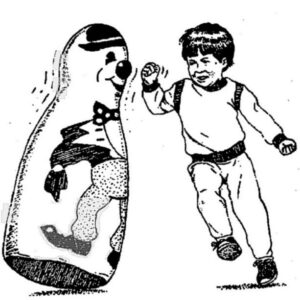
Let’s take a look at a few examples of social learning:
Bobo Doll Experiment
One famous example of social learning is the Bobo Doll experiment. In this experiment, children were shown a film of an adult behaving aggressively towards a Bobo doll. The children then imitated the behavior they had seen in the film. This showed that children can learn aggressive behavior by observing others.
What We Learn From Bobo Doll Experiment
The Bobo Doll experiment taught us that children learn by observing and imitating the behavior of others. This is an important finding because it helps us to understand how children learn aggressive behavior. It also helps us to understand why violence is often passed down from one generation to the next.
Inference
Children were more likely to imitate the behavior of people they saw as role models and they were also more likely to imitate the negative behaviors of those role models. In this way, this experiment helped to show the importance of social interaction in learning.
Evaluating Social Learning Theory
Now that we’ve looked at some examples of social learning, let’s evaluate the theory.
Viability of social learning theory: Social learning theory is based on the idea that people can learn by observing and imitating others. This means that it is a very practical theory, as it can be applied in several different settings.
Stability of social learning theory: Social learning theory has been studied extensively and there is a great deal of evidence to support it. This means that it is a credible theory that has been backed up by research.
Scope of social learning theory: Social learning theory can be applied to a variety of different settings, including educational and workplace settings. This makes it a versatile theory that can be used in several different situations.
Strengths and weaknesses of social learning theory: The strengths of social learning theory include its practicality and its ability to explain a variety of different behaviors. The weaknesses of social learning theory include its reliance on observation and imitation, which can be limited in some situations.
Limitations of Social Learning Theory
While social learning theory is a practical and credible theory, there are some limitations to it.
- One of the main limitations is that it relies on observation and imitation, which can be limited in some situations. For example, if someone is not exposed to certain behaviors, they will not be able to learn them.
- Additionally, social learning theory does not always take into account individual differences, which can be important in some situations.
NOTE: Theories are important, but they are not always perfect. Theories help us to understand how things work, but they cannot always explain everything. For example, social learning theory cannot always explain why some people are more likely to imitate the behavior of their managers than others. However, understanding the strengths and weaknesses of social learning theory can help us to better understand how people learn.
Applying Social Learning Theory
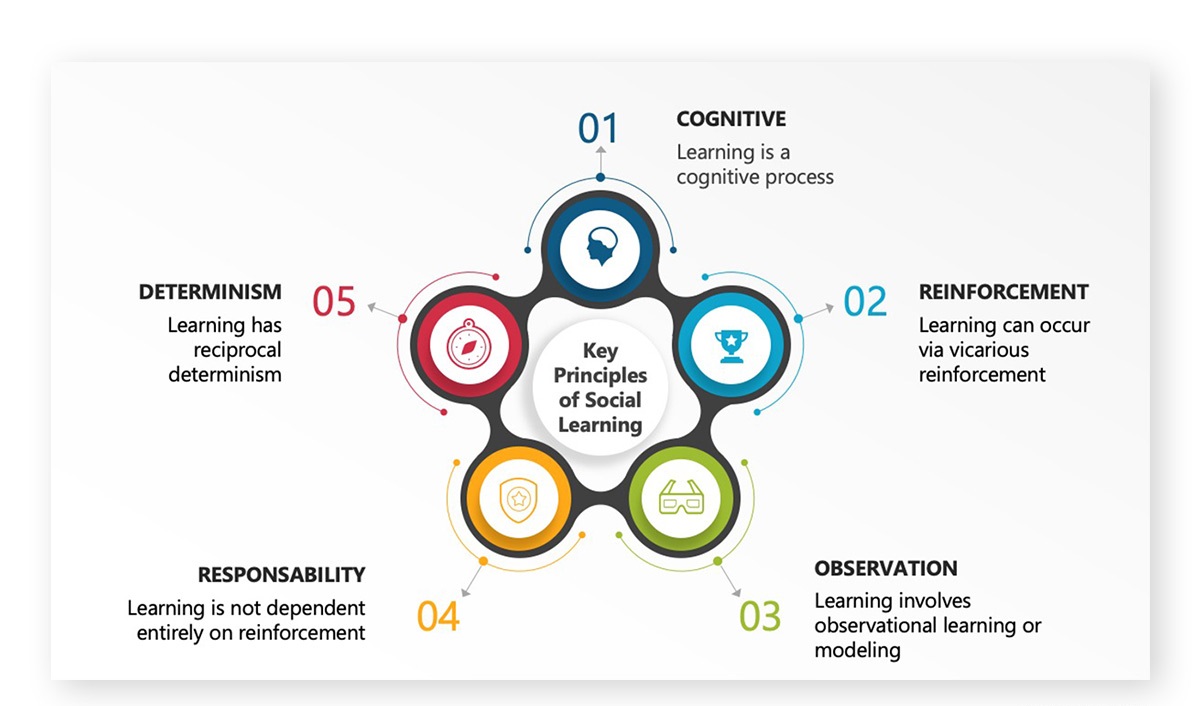
We can apply social learning theory in several ways:
- The first way we can apply social learning theory is by using it to understand how children learn.
- The second way we can apply social learning theory is by using it to understand how people learn in the workplace.
- The third way we can apply social learning theory is by using it to understand how people learn in different settings.
Each of these ways of applying social learning theory has its own strengths and weaknesses.
Educational setting: Social learning theory can be used in the educational setting to help explain how children learn. For example, teachers can use it to understand why some students are more likely to imitate aggressive behavior than others.
Workplace setting: Social learning theory can also be helpful in the workplace setting to help explain how organizations run. For example, it can help to explain why some employees are more likely to imitate the behavior of their managers than others.
Political setting: Social learning theory can also be useful in the political setting to depict the political atmosphere of the country. For example, it can help to explain why some people are more likely to imitate the behavior of their political leaders than others.
Economic setting: Social learning theory can also be helpful in the economic setting to predict policy planning. For example, it can help to explain why some countries are more likely to imitate the behavior of other countries when it comes to economic policy.
Marketing setting: Social learning theory can also be useful in the marketing setting for successful product launches. For example, it can help to explain why some people are more likely to imitate the behavior of celebrities when it comes to fashion.
Studying Different Learning Theories
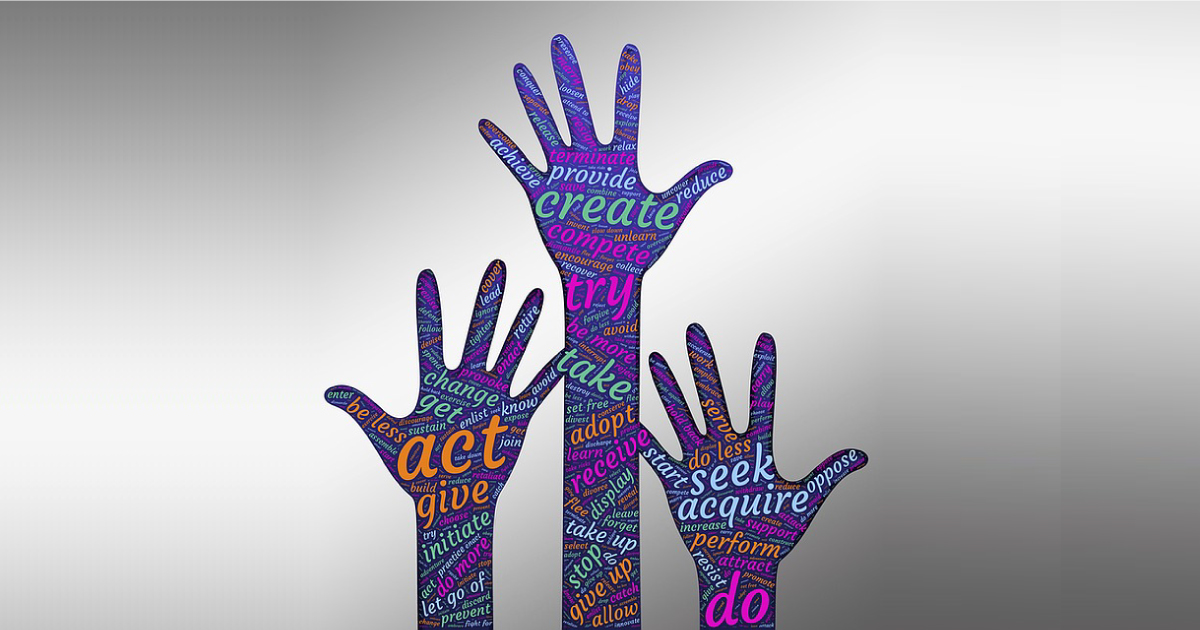
When we study different learning theories, it can help us to better understand how people learn. For example, when we study social learning theory, we can see that people are more likely to imitate the behavior of others. This is an important thing to remember when teaching or training employees.
- When we study cognitive learning theory, we can see that people learn by understanding and remembering information. This is important to remember when designing educational materials.
- When we study behavioral learning theory, we can see that people learn by observing the consequences of their behavior. This is important to remember when setting up reinforcement systems.
- When we study constructivist learning theory, we can see that people learn by building on their prior knowledge. This is important to remember when designing educational materials.
NOTE: Each of these learning theories has its own strengths and weaknesses. By understanding the strengths and weaknesses of each theory, we can better understand how people learn.
Bringing It All Together
When it comes to understanding how people learn, hearing from experts is important. For example:
When we hear from experts in the field of social learning theory, we can understand how people are more likely to imitate the behavior of others. This can help us to better understand why some people are more likely to behave aggressively than others.
When we hear from experts in the field of cognitive learning theory, we can understand how people learn by understanding and remembering information. This can help us to better understand why some people are more likely to remember things than others.
When we hear from experts in the field of behavioral learning theory, we can understand how people learn by observing the consequences of their behavior. This can help us to better understand why some people are more likely to behave differently when they are in different situations.
When we hear from experts in the field of constructivist learning theory, we can understand how people learn by building on their prior knowledge. This can help us to better understand why some people are more likely to remember things than others.
NOTE: It is important to remember that each person learns differently. By understanding the different ways that people learn, we can better understand how to teach or train employees.
Importance of Resources
When it comes to understanding how people learn, resources are important. For example, when we have access to good educational materials, we can understand how people learn by understanding and remembering information. This is important to remember when designing educational materials.
When we have access to good reinforcement systems, we can understand how people learn by observing the consequences of their behavior. This is important to remember when setting up reinforcement systems.
When we have access to good examples, we can understand how people are more likely to imitate the behavior of others. This is important to remember when teaching or training employees.
NOTE: It is important to have a variety of resources available when trying to understand how people learn. By having a variety of resources available, we can better understand how people learn in different ways.
Conclusion
In conclusion, it is important to understand how people learn. By understanding the different learning theories, we can better understand how to teach or train employees. Additionally, by hearing from experts and having access to good resources, we can better understand how people learn in different ways. Finally, by remembering that each person learns differently, we can better understand how to teach or train employees.
A Word From Therapy Mantra
Your mental health — Your psychological, emotional, and social well-being — has an impact on every aspect of your life. Positive mental health essentially allows you to effectively deal with life’s everyday challenges.
At TherapyMantra, we have a team of therapists who provide affordable online therapy to assist you with issues such as depression, anxiety, stress, workplace Issues, addiction, relationship, OCD, LGBTQ, and PTSD. You can book a free therapy or download our free Android or iOS app.
